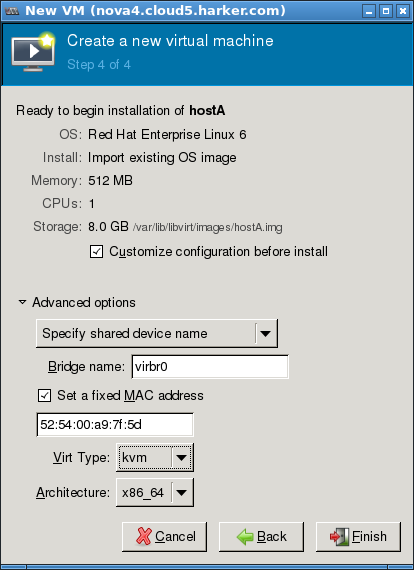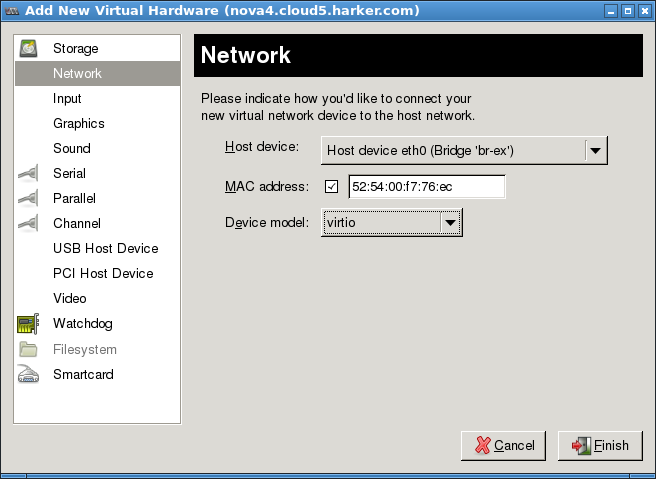














Robert Harker <harker@harker.com>
North Bay Linux Users Group
January 13, 2015
The slides are available at: http://harker.com/Talks/linux-bridging/



Linux Bridging In A Virtualized Environment by
Robert Harker
is licensed under a
Creative Commons Attribution 3.0 Unported License.
Hit the space bar or swipe left for next slide
Understanding the mysteries and wonders of Linux Bridging:
We are ignoring IPv6 and the iproute2 bridge command in this talk
Robert Harker:
Unix gray beard sysadmin
Converted to Linux in the late 1990's
Taught TCP/IP networking at UCSC Extension in the early 1990's
Interested in OpenStack. Built my own 5 node stack: cloud5.harker.com
Interested in DevOps. Worked in Yahoo Sports as they automated
Slides prepared using vi and W3C Slidy,
A 6 file CSS styles sheets and Java script presentation system/template.
Linux bridging creates device nodes in the kernel that behave the same as physical hardware
This allows all the standard networking tools and libraries to work without change
Think of a Linux bridge device as a dumb Ethernet hub,
It forwards packets to anything connected to the bridge
Originally created to support VPN (I think)
Virtual Private Networking, VPN, needs to have a private sub-net so they can route remote traffic through the VPN encryption interface
Physical segments are implemented in real hardware:
Virtual segments are implemented in software:
Maps the mac address of an interface to the device name:
/etc/udev/rules.d/70-persistent-net.rules:
# PCI device 0x10de:0x0373 (forcedeth)
SUBSYSTEM=="net", ACTION=="add", DRIVERS=="?*", ATTR{address}=="00:03:25:44:99:b6", \
ATTR{type}=="1", KERNEL=="eth*", NAME="eth0"
Configures the eth0 interface (RHEL/CentOS):
/etc/sysconfig/network-scripts/ifcfg-eth0: DEVICE="eth0" TYPE="Ethernet" HWADDR="00:03:25:44:99:B6" ONBOOT="yes" IPADDR="10.5.0.196" PREFIX="24" GATEWAY="10.5.0.254"
If using Linux bridges it is wise to not use NetworkManager:
yum erase NetworkManager\*
The good old fashion ifconfig command:
# ifconfig eth0
eth0 Link encap:Ethernet HWaddr 00:03:25:44:99:B6
inet addr:10.5.0.196 Bcast:10.5.0.255 Mask:255.255.255.0
inet6 addr: fe80::203:25ff:fe44:99b6/64 Scope:Link
UP BROADCAST RUNNING MULTICAST MTU:1500 Metric:1
RX packets:13 errors:0 dropped:0 overruns:0 frame:0
TX packets:35 errors:0 dropped:0 overruns:0 carrier:0
collisions:0 txqueuelen:1000
RX bytes:2218 (2.1 KiB) TX bytes:3370 (3.2 KiB)
Interrupt:24 Base address:0xa000
The spiffy "all in one" ip command:
ip address show dev eth0
2: eth0: <BROADCAST,MULTICAST,UP,LOWER_UP> mtu 1500 qdisc pfifo_fast state UNKNOWN qlen 1000
link/ether 00:03:25:44:99:b6 brd ff:ff:ff:ff:ff:ff
inet 10.5.0.196/24 brd 10.5.0.255 scope global eth0
inet6 fe80::203:25ff:fe44:99b6/64 scope link
valid_lft forever preferred_lft forever
brctl is the standard bridge configuration tool
The package bridge-utils installs the brctl command:
yum install bridge-utils
bridge is part of iproute2 package
My understanding is that bridge is a command shell
wrapped around the iproute2 bridge management API.
We do not talk about the bridge command anymore
Comparison of brctl and bridge commands:
http://sgros-students.blogspot.com/2013/11/comparison-of-brctl-and-bridge-commands.html
Delete an IP address from the physical interface
# ip addr del 10.5.0.196/24 dev eth0
Create the virtual bridge
# brctl addbr br-ex
Add physical interface to virtual bridge
# brctl addif br-ex eth0
Display information about the bridge
# brctl show bridge name bridge id STP enabled interfaces br-ex 8000.0003254499b6 no eth0 # brctl showmacs br-ex port no mac addr is local? ageing timer 1 00:03:25:44:99:b6 yes 0.00
Add an IP address to the bridge
ip addr add 10.5.0.196/24 dev br-ex
# ifconfig eth0
eth0 Link encap:Ethernet HWaddr 00:03:25:44:99:B6
inet6 addr: fe80::203:25ff:fe44:99b6/64 Scope:Link
UP BROADCAST RUNNING MULTICAST MTU:1500 Metric:1
RX packets:13 errors:0 dropped:0 overruns:0 frame:0
TX packets:65 errors:0 dropped:0 overruns:0 carrier:0
collisions:0 txqueuelen:1000
RX bytes:2218 (2.1 KiB) TX bytes:5642 (5.5 KiB)
Interrupt:24 Base address:0xa000
# ifconfig br-ex
br-ex Link encap:Ethernet HWaddr 00:03:25:44:99:B6
inet addr:10.5.0.196 Bcast:10.5.0.255 Mask:255.255.255.0
inet6 addr: fe80::203:25ff:fe44:99b6/64 Scope:Link
UP BROADCAST RUNNING MULTICAST MTU:1500 Metric:1
RX packets:0 errors:0 dropped:0 overruns:0 frame:0
TX packets:10 errors:0 dropped:0 overruns:0 carrier:0
collisions:0 txqueuelen:0
RX bytes:0 (0.0 b) TX bytes:636 (636.0 b)
Note: Physical interfaces have interrupts, bridge devices do not
DEVICE="eth0" TYPE="Ethernet" HWADDR="00:03:25:44:99:B6" ONBOOT="yes" BRIDGE="br-ex" # No IPADDR related settings
DEVICE="br-ex" TYPE="Bridge" ONBOOT="yes" # IPADDR set for bridge interface IPADDR="10.5.0.196" PREFIX="24" GATEWAY="10.5.0.254"
If an internal bridge is not connected to a IP forwarding node, then the bridge is an isolated subnet.
An IP forwarding or router node is required for hosts on the bridge to communicate with hosts on other networks:
Install the virtualization packages with yum:
hypervisor# yum install libvirt virt-manager qemu-img qemu-kvm qemu-kvm-tools
The qemu-guest-agent package should be installed in your guest images:
hostA# yum install qemu-guest-agent
When you install Qemu a default virtual network is created:

# brctl show bridge name bridge id STP enabled interfaces br-ex 8000.0003254499b6 no eth0 virbr0 8000.525400aad8a5 yes virbr0-nic # brctl showmacs virbr0 port no mac addr is local? ageing timer 1 52:54:00:aa:d8:a5 yes 0.00
# ip address show dev virbr0
5: virbr0: <BROADCAST,MULTICAST,UP,LOWER_UP> mtu 1500 qdisc noqueue state UNKNOWN
link/ether 52:54:00:aa:d8:a5 brd ff:ff:ff:ff:ff:ff
inet 192.168.122.1/24 brd 192.168.122.255 scope global virbr0
# ip address show dev virbr0-nic
6: virbr0-nic: <BROADCAST,MULTICAST> mtu 1500 qdisc noop state DOWN qlen 500
link/ether 52:54:00:aa:d8:a5 brd ff:ff:ff:ff:ff:ff
# ip route 10.5.0.0/24 dev br-ex proto kernel scope link src 10.5.0.196 192.168.122.0/24 dev virbr0 proto kernel scope link src 192.168.122.1 default via 10.5.0.254 dev br-ex
# ps ax | grep dnsmasq | grep -v grep
1726 ? S 0:00 /usr/sbin/dnsmasq --strict-order \
--pid-file=/var/run/libvirt/network/default.pid --conf-file= --except-interface lo --bind-interfaces \
--listen-address 192.168.122.1 --dhcp-range 192.168.122.2,192.168.122.254 \
--dhcp-leasefile=/var/lib/libvirt/dnsmasq/default.leases --dhcp-lease-max=253 --dhcp-no-override \
--dhcp-hostsfile=/var/lib/libvirt/dnsmasq/default.hostsfile \
--addn-hosts=/var/lib/libvirt/dnsmasq/default.addnhosts
iptables -L -t nat . . . Chain POSTROUTING (policy ACCEPT) target prot opt source destination MASQUERADE tcp -- 192.168.122.0/24 !192.168.122.0/24 masq ports: 1024-65535 MASQUERADE udp -- 192.168.122.0/24 !192.168.122.0/24 masq ports: 1024-65535 MASQUERADE all -- 192.168.122.0/24 !192.168.122.0/24 . . .
The default.xml file defines the default bridge virbr0
This file is linked into /etc/libvirt/qemu/networks/autostart so the bridge will be created when the system boots
/etc/libvirt/qemu/networks/default.xml:
<network>
<name>default</name>
<uuid>add42c9b-eca6-456d-8e94-605a64d0091f</uuid>
<bridge name="virbr0" />
<mac address='52:54:00:AA:D8:A5'/>
<forward/>
<ip address="192.168.122.1" netmask="255.255.255.0">
<dhcp>
<range start="192.168.122.2" end="192.168.122.254" />
</dhcp>
</ip>
</network>
Hint: you can create unique UUIDs with uuidgen:
# uuidgen bbb2bfbd-e8a9-4004-b2ff-07f6cbfb5a3b
Use virt-manage to create a two node network connected to virbr0
Verify network configuration:
Advanced options: Specify shared device name Bridge name: virbr0

brctl shows that two new interfaces have been created on virbr0
# brctl show virbr0 bridge name bridge id STP enabled interfaces virbr0 8000.525400aad8a5 yes virbr0-nic vnet0 vnet1
# brctl showmacs virbr0 port no mac addr is local? ageing timer 1 52:54:00:aa:d8:a5 yes 0.00 3 fe:54:00:14:e3:04 yes 0.00 2 fe:54:00:a9:7f:5d yes 0.00
ip shows these configured interfaces
Note: no IP addresses are assigned to vnet0 or vnet1
# ip address
. . .
8: vnet0: <BROADCAST,MULTICAST,UP,LOWER_UP> mtu 1500 qdisc pfifo_fast state UNKNOWN qlen 500
link/ether fe:54:00:a9:7f:5d brd ff:ff:ff:ff:ff:ff
inet6 fe80::fc54:ff:fea9:7f5d/64 scope link
valid_lft forever preferred_lft forever
9: vnet1: <BROADCAST,MULTICAST,UP,LOWER_UP> mtu 1500 qdisc pfifo_fast state UNKNOWN qlen 500
link/ether fe:54:00:14:e3:04 brd ff:ff:ff:ff:ff:ff
inet6 fe80::fc54:ff:fe14:e304/64 scope link
valid_lft forever preferred_lft forever
The dnsmasq default.leases shows the IP addresses assigned to the two instances
# cat /var/lib/libvirt/dnsmasq/default.leases 1400098542 52:54:00:14:e3:04 192.168.122.110 * * 1400098843 52:54:00:a9:7f:5d 192.168.122.133 * *
virsh can show information about virtual networks:
virsh # net-list Name State Autostart Persistent -------------------------------------------------- default active yes yes virsh # net-info default Name default UUID 0bd45d0a-be77-4c7d-aa33-426c025196be Active: yes Persistent: yes Autostart: yes Bridge: virbr0
virsh can show information about virtual interfaces on an instance:
virsh # domiflist hostA Interface Type Source Model MAC ------------------------------------------------------- vnet0 bridge virbr0 virtio 52:54:00:a9:7f:5d virsh # domifstat hostA vnet0 vnet0 rx_bytes 11235011 vnet0 rx_packets 8852 vnet0 rx_errs 0 vnet0 rx_drop 0 vnet0 tx_bytes 54692 vnet0 tx_packets 785 vnet0 tx_errs 0 vnet0 tx_drop 0
virsh is a command line tool to manage libvirt resources
Part of libvirt-client package
The eth0 device looks like a normal Ethernet interface:
Note: There is no "Interrupt:" line because it is a virtual interface
hostA ~ # ifconfig eth0
eth0 Link encap:Ethernet HWaddr 52:54:00:A9:7F:5D
inet addr:192.168.122.133 Bcast:192.168.122.255 Mask:255.255.255.0
inet6 addr: fe80::5054:ff:fea9:7f5d/64 Scope:Link
UP BROADCAST RUNNING MULTICAST MTU:1500 Metric:1
RX packets:10702 errors:0 dropped:0 overruns:0 frame:0
TX packets:999 errors:0 dropped:0 overruns:0 carrier:0
collisions:0 txqueuelen:1000
RX bytes:11347743 (10.8 MiB) TX bytes:84647 (82.6 KiB)
hostA ~ # ip address show dev eth0
2: eth0: <BROADCAST,MULTICAST,UP,LOWER_UP> mtu 1500 qdisc pfifo_fast state UP qlen 1000
link/ether 52:54:00:a9:7f:5d brd ff:ff:ff:ff:ff:ff
inet 192.168.122.133/24 brd 192.168.122.255 scope global eth0
inet6 fe80::5054:ff:fea9:7f5d/64 scope link
valid_lft forever preferred_lft forever
The instance has a default route through the hypervisor host 192.168.122.1:
hostA ~ # ip route 192.168.122.0/24 dev eth0 proto kernel scope link src 192.168.122.133 169.254.0.0/16 dev eth0 scope link metric 1002 default via 192.168.122.1 dev eth0
What is this?
Is this a Sun extension?
Disable by adding to /etc/sysconfig/network:
NOZEROCONF=yes
tcpdump can be used to monitor traffic on a virtual bridge:
hypervisor# tcpdump -i virbr0 tcpdump: verbose output suppressed, use -v or -vv for full protocol decode listening on virbr0, link-type EN10MB (Ethernet), capture size 65535 bytes
> hostA# ping 192.168.122.110
12:38:31.278548 ARP, Request who-has 192.168.122.110 tell 192.168.122.133, length 28 12:38:31.279019 ARP, Reply 192.168.122.110 is-at 52:54:00:14:e3:04 (oui Unknown), length 28 12:38:31.279146 IP 192.168.122.133 > 192.168.122.110: ICMP echo request, id 29444, seq 1, length 64 12:38:31.279792 IP 192.168.122.110 > 192.168.122.133: ICMP echo reply, id 29444, seq 1, length 64 12:38:32.279219 IP 192.168.122.133 > 192.168.122.110: ICMP echo request, id 29444, seq 2, length 64 12:38:32.279452 IP 192.168.122.110 > 192.168.122.133: ICMP echo reply, id 29444, seq 2, length 64
Very useful for debugging networking problems
hostA's virtual NIC is defined in its qemu hostA.xml file
In the <interface></interface> stanza
/etc/libvirt/qemu/hostA.xml:
<domain type='kvm'>
<name>hostA</name>
. . .
<interface type='bridge'>
<mac address='52:54:00:a9:7f:5d'/>
<source bridge='virbr0'/>
<target dev='vnet0'/>
<model type='virtio'/>
<alias name='net0'/>
<address type='pci' domain='0x0000' bus='0x00' slot='0x03' function='0x0'/>
</interface>
. . .
</domain>
You can dump the current running in memory copy of this XML with virsh:
virsh # dumpxml hostA
In a traditional 3 layer web site design you have:
All three types of nodes talk to each other over a private internal network
Only the FE nodes received incoming TCP/IP connections from the Internet
In a production "all in one" virtualized environment the web site will have:
The private virtual network will have outgoing access to the Internet via the hypervisor
The hypervisor hosts will perform iptables NATing for the virtual subnet
ssh access to the instances on the private virtual subnet is left as an exercise for the student
Hint: It involves IP routing
I call this collection of 3 instances and a private subnet a "runway"
It has all the pieces needed to run the web site application in development mode
Host device: Host device eth0 (Bridge br-ex) Device model: virtio
Reboot the instance for changes to take effect

After rebooting the instance inspect its network configuration:
hostA ~ # ip address
. . .
2: eth0: <BROADCAST,MULTICAST,UP,LOWER_UP> mtu 1500 qdisc pfifo_fast state UP qlen 1000
link/ether 52:54:00:a9:7f:5d brd ff:ff:ff:ff:ff:ff
inet 192.168.122.133/24 brd 192.168.122.255 scope global eth0
inet6 fe80::5054:ff:fea9:7f5d/64 scope link
valid_lft forever preferred_lft forever
3: eth1: <BROADCAST,MULTICAST,UP,LOWER_UP> mtu 1500 qdisc pfifo_fast state UP qlen 1000
link/ether 52:54:00:f7:76:ec brd ff:ff:ff:ff:ff:ff
inet6 fe80::5054:ff:fef7:76ec/64 scope link
valid_lft forever preferred_lft forever
Note: No IP address assigned to eth1
hostA ~ # ifconfig eth1
eth1 Link encap:Ethernet HWaddr 52:54:00:F7:76:EC
inet6 addr: fe80::5054:ff:fef7:76ec/64 Scope:Link
UP BROADCAST RUNNING MULTICAST MTU:1500 Metric:1
RX packets:36 errors:0 dropped:0 overruns:0 frame:0
TX packets:39 errors:0 dropped:0 overruns:0 carrier:0
collisions:0 txqueuelen:1000
RX bytes:6772 (6.6 KiB) TX bytes:4262 (4.1 KiB)
Note: There is no "Interrupt:" line because it is a virtual interface
Configure the interfaces to use dhcp and set the default route through eth1, the external interface
/etc/sysconfig/network-scripts/ifcfg-eth0" DEVICE="eth0" BOOTPROTO="dhcp" ONBOOT="yes" TYPE="Ethernet" # Note: no HWADDR or UUID IPV4_FAILURE_FATAL=yes IPV6INIT=no LAST_CONNECT=1397607178
/etc/sysconfig/network-scripts/ifcfg-eth1: DEVICE="eth1" TYPE="Ethernet" ONBOOT="yes" BOOTPROTO="dhcp" # Note: no HWADDR or UUID DEFROUTE=yes PEERDNS=yes PEERROUTES=yes IPV4_FAILURE_FATAL=yes IPV6INIT=no LAST_CONNECT=1397607178
hostA ~ # ip address
. . .
2: eth0: <BROADCAST,MULTICAST,UP,LOWER_UP> mtu 1500 qdisc pfifo_fast state UP qlen 1000
link/ether 52:54:00:a9:7f:5d brd ff:ff:ff:ff:ff:ff
inet 192.168.122.133/24 brd 192.168.122.255 scope global eth0
inet6 fe80::5054:ff:fea9:7f5d/64 scope link
valid_lft forever preferred_lft forever
3: eth1: <BROADCAST,MULTICAST,UP,LOWER_UP> mtu 1500 qdisc pfifo_fast state UP qlen 1000
link/ether 52:54:00:f7:76:ec brd ff:ff:ff:ff:ff:ff
inet 10.5.0.37/24 brd 10.5.0.255 scope global eth1
inet6 fe80::5054:ff:fef7:76ec/64 scope link
valid_lft forever preferred_lft forever
hostA # ip route 10.5.0.0/24 dev eth1 proto kernel scope link src 10.5.0.37 192.168.122.0/24 dev eth0 proto kernel scope link src 192.168.122.133 default via 10.5.0.254 dev eth1
Note: Default route is through external interface eth1
hostA # traceroute -n 192.168.122.110 traceroute to 192.168.122.110 (192.168.122.110), 30 hops max, 60 byte packets 1 192.168.122.110 0.596 ms !X 0.539 ms !X 0.526 ms !X
hostA # traceroute -n 192.168.42.1 traceroute to 192.168.42.1 (192.168.42.1), 30 hops max, 60 byte packets 1 10.5.0.254 0.590 ms 0.518 ms 0.503 ms 2 192.168.42.1 7.454 ms 7.488 ms 7.477 ms
hostA # traceroute -n 192.168.122.133 traceroute to 192.168.122.133 (192.168.122.133), 30 hops max, 60 byte packets 1 192.168.122.133 0.210 ms !X 0.095 ms !X 0.418 ms !X
hostA # traceroute -n 192.168.42.1 traceroute to 192.168.42.1 (192.168.42.1), 30 hops max, 60 byte packets 1 192.168.122.1 0.759 ms 0.651 ms 0.597 ms 2 10.5.0.254 0.576 ms 0.568 ms 0.554 ms 3 192.168.42.1 4.150 ms 4.150 ms 4.130 ms
Note 1st hop is to hypervisor NAT interface 192.168.122.1
Converting a dual homed host into a route are just the steps required to set up a Linux based router
This is left as an exersize for the student :-)
Are there newer routing protocols that would work better?